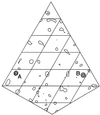Physicochemical evidence that Treponema pallidum TroA is a zinc-containing metalloprotein that lacks porin-like structure
- PMID: 10400603
- PMCID: PMC93947
- DOI: 10.1128/JB.181.14.4420-4423.1999
Physicochemical evidence that Treponema pallidum TroA is a zinc-containing metalloprotein that lacks porin-like structure
Abstract
Although TroA (Tromp1) was initially reported to be a Treponema pallidum outer membrane protein with porin-like properties, subsequent studies have suggested that it actually is a periplasmic substrate-binding protein involved in the transport of metals across the treponemal cytoplasmic membrane. Here we conducted additional physicochemical studies to address the divergent viewpoints concerning this protein. Triton X-114 phase partitioning of recombinant TroA constructs with or without a signal sequence corroborated our prior contention that the native protein's amphiphilic behavior is due to its uncleaved leader peptide. Whereas typical porins are trimers with extensive beta-barrel structure, size exclusion chromatography and circular dichroism spectroscopy revealed that TroA was a monomer and predominantly alpha-helical. Neutron activation, atomic absorption spectroscopy, and anomalous X-ray scattering all demonstrated that TroA binds zinc in a 1:1 molar stoichiometric ratio. TroA does not appear to possess structural features consistent with those of bacterial porins.
Figures



Similar articles
-
Renaturation of recombinant Treponema pallidum rare outer membrane protein 1 into a trimeric, hydrophobic, and porin-active conformation.J Bacteriol. 1999 Dec;181(23):7168-75. doi: 10.1128/JB.181.23.7168-7175.1999. J Bacteriol. 1999. PMID: 10572117 Free PMC article.
-
Porin activity and sequence analysis of a 31-kilodalton Treponema pallidum subsp. pallidum rare outer membrane protein (Tromp1).J Bacteriol. 1995 Jun;177(12):3556-62. doi: 10.1128/jb.177.12.3556-3562.1995. J Bacteriol. 1995. PMID: 7768866 Free PMC article.
-
Tromp1, a putative rare outer membrane protein, is anchored by an uncleaved signal sequence to the Treponema pallidum cytoplasmic membrane.J Bacteriol. 1997 Aug;179(16):5076-86. doi: 10.1128/jb.179.16.5076-5086.1997. J Bacteriol. 1997. PMID: 9260949 Free PMC article.
-
Surface antigens of the syphilis spirochete and their potential as virulence determinants.Emerg Infect Dis. 1997 Jan-Mar;3(1):11-20. doi: 10.3201/eid0301.970102. Emerg Infect Dis. 1997. PMID: 9126440 Free PMC article. Review.
-
Treponema pallidum and the quest for outer membrane proteins.Mol Microbiol. 1995 Jun;16(6):1067-73. doi: 10.1111/j.1365-2958.1995.tb02332.x. Mol Microbiol. 1995. PMID: 8577243 Review.
Cited by
-
Biological basis for syphilis.Clin Microbiol Rev. 2006 Jan;19(1):29-49. doi: 10.1128/CMR.19.1.29-49.2006. Clin Microbiol Rev. 2006. PMID: 16418521 Free PMC article. Review.
-
Varied metal-binding properties of lipoprotein PsaA in Streptococcus pneumoniae.J Biol Inorg Chem. 2014 Aug;19(6):829-38. doi: 10.1007/s00775-014-1114-9. Epub 2014 Feb 20. J Biol Inorg Chem. 2014. PMID: 24553956
-
Comparison of transcriptional profiles of Treponema pallidum during experimental infection of rabbits and in vitro culture: Highly similar, yet different.PLoS Pathog. 2021 Sep 27;17(9):e1009949. doi: 10.1371/journal.ppat.1009949. eCollection 2021 Sep. PLoS Pathog. 2021. PMID: 34570834 Free PMC article.
-
The Tp38 (TpMglB-2) lipoprotein binds glucose in a manner consistent with receptor function in Treponema pallidum.J Bacteriol. 2004 Apr;186(8):2303-8. doi: 10.1128/JB.186.8.2303-2308.2004. J Bacteriol. 2004. PMID: 15060032 Free PMC article.
-
Biophysical insights into a highly selective l-arginine-binding lipoprotein of a pathogenic treponeme.Protein Sci. 2018 Dec;27(12):2037-2050. doi: 10.1002/pro.3510. Epub 2018 Oct 27. Protein Sci. 2018. PMID: 30242931 Free PMC article.
References
-
- Blanco D R, Giladi M, Champion C I, Haake D A, Chikami G K, Miller J N, Lovett M A. Identification of Treponema pallidum subspecies pallidum genes encoding signal peptides and membrane-spanning sequences using a novel alkaline phosphatase expression vector. Mol Microbiol. 1991;5:2405–2415. - PubMed
Publication types
MeSH terms
Substances
Grants and funding
LinkOut - more resources
Full Text Sources

